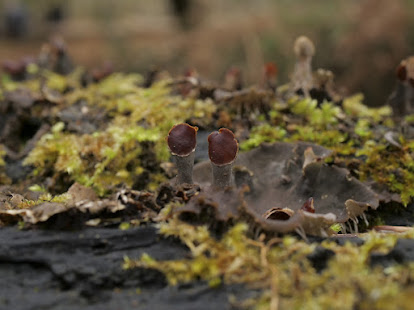We gathered in Acre’s Down car park on a mild, overcast day to walk
across the down and over to Wick Wood and back. A short climb up the farm track
brings us out onto the edge of Acre’s Down where we pause to enjoy the view
across the valley and scan the horizon for any raptor activity. No Goshawk
today but a distant Buzzard circled above the tree line.
Woodlarks were heard
and one was spotted singing in flight, the short tail and almost bat like
appearance as it flew identifying it, together with the descending notes of its
song. It perched obligingly for some time, allowing further good views. Walking
across the down we heard several more Woodlarks calling amongst the heather and
bracken. A Meadow Pipit was also seen in flight and Great Spotted Woodpecker
could be heard drumming.
 |
Woodlark © Chris Robinson |
Descending from the Down, we noted Butchers Broom growing amongst the
Holly that line this path, before turning into a small clearing of large Beech
trees where Great Tit and a Treecreeper were seen.
 |
Treecreeper © Chris Robinson |
We paused to look and ponder
the cause for a single beech tree that has extensive callus formation in the
crown, with several woody remnants littering the ground beside it. Thanks to
the combined wisdom of the group, a bacterial pathogen seems to be the most
likely explanation1 though curiously, no other surrounding trees appear to
be infected.
 |
Beech tree callus © Richard Smith |
There were a few fungi species found including Holly Speckle as well as lichens such as Dog Lichen identified by Sue.
 |
Holly Speckle - © Sue Skarstein |

|
Apothecia of Dog Lichen © Sue Skarstein (above)
and © Claire Kidger (below)
|
Branching right we cross The Knowles on a muddy ride, passing a Beech
tree marked with the small circular NTSP tag 2, identifying it as a candidate
for seed collection for the Millennium Seed Bank at Wakehurst3. Crossing over a footbridge at Bagshot Water brings us back onto the path
running north through Wick Wood where we stopped for coffee. There has been
quite extensive recent felling here, mostly of softwood and some birch. Feeding
amongst the leaf litter and beech mast, we saw good numbers of Chaffinch as
well as Marsh Tit and Coal Tit and a Redpoll was also spotted amongst a group
of finches.
 |
Tree tag © Richard Smith |
A little further along the track, we re-cross Bagshot Gutter, and
here a Grey Wagtail flew up and perched obligingly for a short time. The
surrounding woodland had several of what again sounded like Great Spotted
Woodpecker drumming in the trees but not showing themselves. No sounds of the
softer and more prolonged drum of Lesser Spotted Woodpecker, though this is an
area where they can be seen and heard in early Spring.
 |
Grey Wagtail © Richard Smith |
Rejoining the gravel cycle track, we returned after a short walk, back
to the car park.
 |
Acres Down route © Ordinance Survey |
References
1 https//gardenerspath.com/plants/fruit-trees/burr-knots-and-crown-galls/?fbclid=IwAR25l3A2To79FrtfiFcPZTcz74EyblhBwzvo7He7A7tn6N2usoPc6mEskhY
2 https://www.kew.org/science/our-science/projects/uk-national-tree-seed-project
3 https://www.kew.org/wakehurst/whats-at-wakehurst/millennium-seed-bank





















